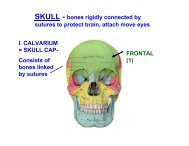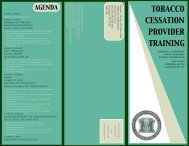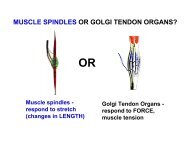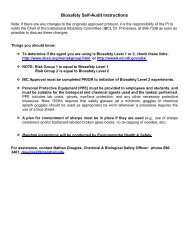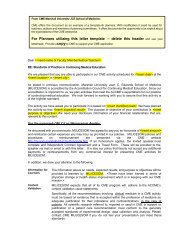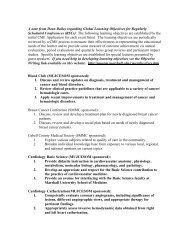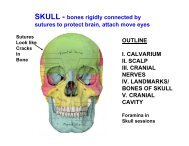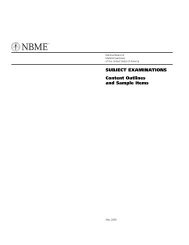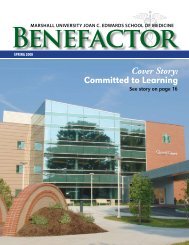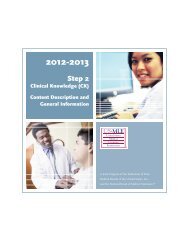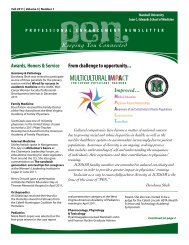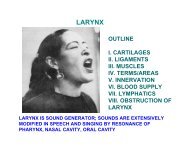FA 5 Progress Report WV-INBRE - Joan C. Edwards School of ...
FA 5 Progress Report WV-INBRE - Joan C. Edwards School of ...
FA 5 Progress Report WV-INBRE - Joan C. Edwards School of ...
- No tags were found...
Create successful ePaper yourself
Turn your PDF publications into a flip-book with our unique Google optimized e-Paper software.
Program Director/Principal Investigator (Last, First, Middle): Rankin, Gary O 80<strong>WV</strong>U Transgenic Animal Core FacilityThe Transgenic Animal Core Facility (TACF) at West Virginia University is a fee-for-service facility that ishoused within the specific pathogen-free (SPF) barrier in the animal quarters at the <strong>WV</strong>U Health SciencesCenter. Our services within the TACF are available to investigators at <strong>WV</strong>U, the National Institute <strong>of</strong>Occupational Safety and Health and the Blanchette Rockefeller Neurosciences Institute. The servicescurrently include 1) pronuclear injection <strong>of</strong> DNA fragments into mouse embryos for producing transgenicanimals; 2) mouse embryonic stem cell injections into developing blastocysts for chimera production; 3)rederivation <strong>of</strong> infected strains; 4) cryopreservation <strong>of</strong> embryos and sperm; 5) resuscitation <strong>of</strong> frozen strains;and 6) speed congenic colony management to change background strains.The barrier facility became operational in January 2004 for housing SPF animals and producing geneticallymodified animals. The current space occupies approximately 2500 square feet <strong>of</strong> space, including threeanimal holding rooms (two mouse and one rat), one procedure room, a transgenic production lab facility, alocker room/changing area, and a general operations/autoclave area. We have the capacity to houseupwards <strong>of</strong> 1850 ventilated cages in the barrier facility. Major equipment includes a stereomicroscope foranimal surgery and embryo manipulation, inverted microscope with Nomarski optics for DNA and ES cellinjection, Sutter micropipette puller, Is<strong>of</strong>lurane anesthesia delivery system, CO2 incubators, laminar flowhood, gel electrophoresis apparatus, controlled-rate freezer, liquid nitrogen cell storage tanks, Eppendorfmicromanipulators and a FemtoJet pressure injection system. We anticipate moving the TACF into the newbarrier space <strong>of</strong> the Animal Facility Annex upon its completion in 2013.The current investigators utilizing TACF services are faculty in the Departments <strong>of</strong> Biochemistry, ExercisePhysiology, Microbiology, Immunology, and Cell Biology, Neurobiology and Anatomy, Ophthalmology, andOtolaryngology. These investigators also represent the Cancer Center, the Sensory NeuroscienceResearch Center and the Center for Cardiovascular and Respiratory Research. Based on a recent survey<strong>of</strong> interested investigators and known transgenic/barrier users, we have identified at least 18 investigators at<strong>WV</strong>U who express a strong to moderate interest in either the transgenic core facility and/or the SPF barrier.Users Unique # Fees Charged Fees Paid by CenterFaculty/Post Doctorate/Staff Yes NoGraduate Students No NoUndergraduate Students No No<strong>WV</strong>U Animal Models and Imaging FacilityThe Animal Models and Imaging Facility (AMIF) <strong>of</strong>fers state-<strong>of</strong>-the-art small animal imaging to West VirginiaUniversity researchers and their collaborators. Conveniently located within the OLAR Animal Facility in the<strong>WV</strong>U Health Sciences Center, the AMIF currently performs acute and longitudinal studies on mice using anIVIS Lumina II for optical (fluorescence and bioluminescence) imaging. This system is <strong>of</strong>ten used tonon-invasively follow tumor formation and metastasis, and has recently been used to study the growth <strong>of</strong>bi<strong>of</strong>ilms using bioluminescent bacteria. The facility also has a new VisualSonics Vevo 2100 for real-time,micro-ultrasound imaging. This system is being used to measure cardiac function, coronary artery flow and3D tumor volumes. We have recently received training for ultrasound contrast applications. In addition, theultrasound is being used for image-guided injections into mouse embryos. Another new addition is a clinicalDEXA scanner that will be available for bone density and body composition analysis. The facility staffprovides additional services, such as cell injections or tissue collections, to assist investigators with theiranimal experiments. The facility staff will maintains compliance with approved animal protocols, in additionto our own approved standard operating procedures, to ensure the health and welfare <strong>of</strong> the animals in ourstudies. The facility is dedicated to providing all the support and services needed for imaging in animalmodels <strong>of</strong> human disease. The animal imaging facility has been supported by the Mary Babb RandolphCancer Center and NIH grants P20 RR016440, P30 RR032138/ GM103488 and S10 RR026378.Users Unique # Fees Charged Fees Paid by CenterFaculty/Post Doctorate/Staff Yes NoPHS 2590 (Rev. 06/09)Continuation Format Page



